V9.com virus (Removal Instructions) - Aug 2017 update
v9.com virus Removal Guide
What is v9.com virus?
v9 virus attempts to control your search experience and present ads instead of search results

v9.com is a very suspicious search site (by Beijing ELEX Technology Co., Ltd.) that might unexpectedly become your homepage one day. It is promoted via suspicious free programs, for example, WPM18.8.0.212. This fake search engine is also known as a browser hijacker[1] which seeks to infect browser shortcuts in order to make web browsers load http://v9.com/ automatically on startup.
If you have already searched the web for an answer to “what is v9.com,” you may have already noticed various discussions on forums about this shady search tool. Some people claim that this is a virus that infiltrated their computers without any permission asked, others believe that it's a normal search engine that can be used just like Google, Yahoo or Bing.
If you don't want to find yourself on suspicious and unknown websites, you should stay away from v9 virus because this search engine may easily show you altered search results that may be filled with questionable links[2]. This technology is used to increase the web traffic to required web sites and promote them in this way.
In addition, when hijacked by v9.com virus, you may notice that each of your web browsers is full of various ads. Every time when trying to search the web you may be interrupted by commercial pop-up ads, alerts about discounts, price comparisons, coupons and similar things.
No matter how trustworthy they look, you should stay away from them as far as you can. Besides, it has been reported that v9 virus can also track people's browsing activity and record related information.
If you think that your search terms, mostly visited websites, time that you spend when visiting your favorite websites or data that you enter when visiting them shouldn't be revealed for third parties, you should take care of V9 removal.
Our experts say that the hijacker is extremely prevalent not only in US, but in France as well, so we strongly suggest French-speaking users visit Lesvirus.fr site[3], which provides spyware removal tutorials in French language.
In fact, it may show up on your machine together with its toolbar and take over your homepage or a default search engine. If you want to avoid that, you should scan your PC with reputable anti-malware and remove v9.com without any delay. For that we highly recommend using FortectIntego.

Suggestions on how to avoid installing potentially unwanted programs
Search.V9.com can get on your computer with a help of several ways: you can download it together with freeware or shareware, or you can simply set this search site as your start page or default search engine voluntarily.
In order to avoid installing the defined browser hijacker unwillingly, you have to double check your security software and try to select only Custom or Advanced installation of the freeware. If this hijacker manages to get inside the system, it may start doing everything to get ability to initiate its redirections.
So, it may alter web browser settings, change the homepage or default search engine settings and initiate other suspicious activities.
Of course, all these changes are made without any permission asked. After that you may be forced to visit this website against your will and, unfortunately, that's not the end. In addition, you may start seeing various pop-up advertisements, start suffering from redirects, slow downs and other issues.
Quick way to remove V9.com redirect virus from the system
If you think you are infected with v9.com virus, you should run a full system scan with automated anti-malware or anti-virus program, or follow these manual removal steps. Please, be very careful if using this removal methods and make that you follow every step in right order to avoid system damage.
To remove v9.com, you will have to dedicate some time and read the instructions provided below the article. If you are looking for a faster way to complete v9.com removal, consider using a decent anti-spyware or anti-malware software.
You may remove virus damage with a help of FortectIntego. SpyHunter 5Combo Cleaner and Malwarebytes are recommended to detect potentially unwanted programs and viruses with all their files and registry entries that are related to them.
Getting rid of v9.com virus. Follow these steps
Uninstall from Windows
Uninstall V9 and WPM18.8.0.212 via Control Panel. Check if you can find any other shady-looking entries and uninstall them as well. Finally and most importantly, fix browser shortcuts altered by the virus. You need to delete everything that is written after .exe” part (you should find http://v9.com or http://en.v9.com/ link there).
Instructions for Windows 10/8 machines:
- Enter Control Panel into Windows search box and hit Enter or click on the search result.
- Under Programs, select Uninstall a program.

- From the list, find the entry of the suspicious program.
- Right-click on the application and select Uninstall.
- If User Account Control shows up, click Yes.
- Wait till uninstallation process is complete and click OK.

If you are Windows 7/XP user, proceed with the following instructions:
- Click on Windows Start > Control Panel located on the right pane (if you are Windows XP user, click on Add/Remove Programs).
- In Control Panel, select Programs > Uninstall a program.

- Pick the unwanted application by clicking on it once.
- At the top, click Uninstall/Change.
- In the confirmation prompt, pick Yes.
- Click OK once the removal process is finished.
Delete from macOS
Remove items from Applications folder:
- From the menu bar, select Go > Applications.
- In the Applications folder, look for all related entries.
- Click on the app and drag it to Trash (or right-click and pick Move to Trash)

To fully remove an unwanted app, you need to access Application Support, LaunchAgents, and LaunchDaemons folders and delete relevant files:
- Select Go > Go to Folder.
- Enter /Library/Application Support and click Go or press Enter.
- In the Application Support folder, look for any dubious entries and then delete them.
- Now enter /Library/LaunchAgents and /Library/LaunchDaemons folders the same way and terminate all the related .plist files.

Remove from Microsoft Edge
Delete unwanted extensions from MS Edge:
- Select Menu (three horizontal dots at the top-right of the browser window) and pick Extensions.
- From the list, pick the extension and click on the Gear icon.
- Click on Uninstall at the bottom.
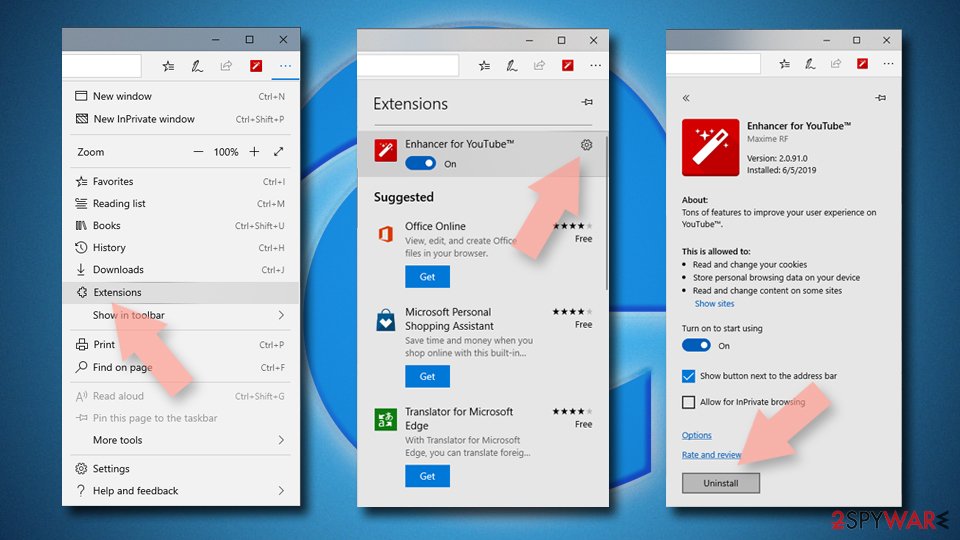
Clear cookies and other browser data:
- Click on the Menu (three horizontal dots at the top-right of the browser window) and select Privacy & security.
- Under Clear browsing data, pick Choose what to clear.
- Select everything (apart from passwords, although you might want to include Media licenses as well, if applicable) and click on Clear.
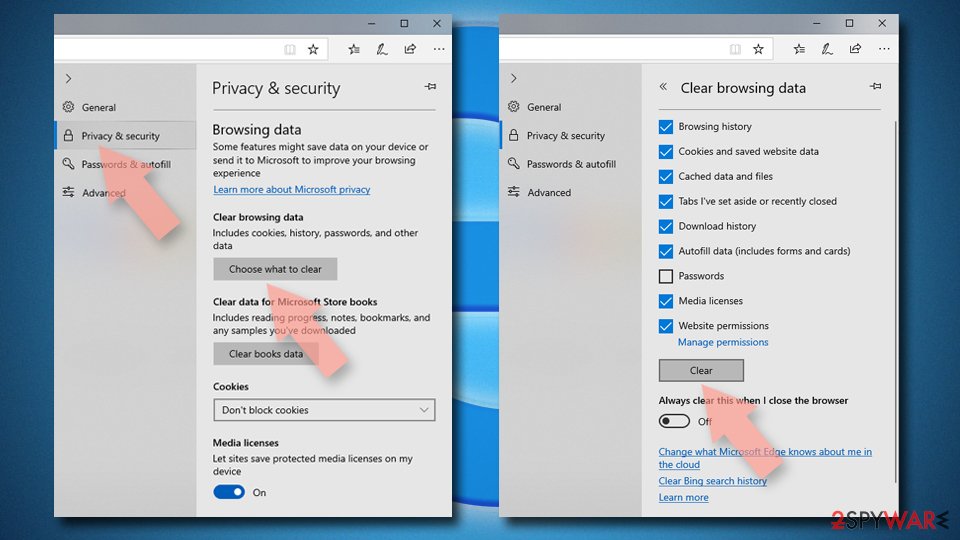
Restore new tab and homepage settings:
- Click the menu icon and choose Settings.
- Then find On startup section.
- Click Disable if you found any suspicious domain.
Reset MS Edge if the above steps did not work:
- Press on Ctrl + Shift + Esc to open Task Manager.
- Click on More details arrow at the bottom of the window.
- Select Details tab.
- Now scroll down and locate every entry with Microsoft Edge name in it. Right-click on each of them and select End Task to stop MS Edge from running.
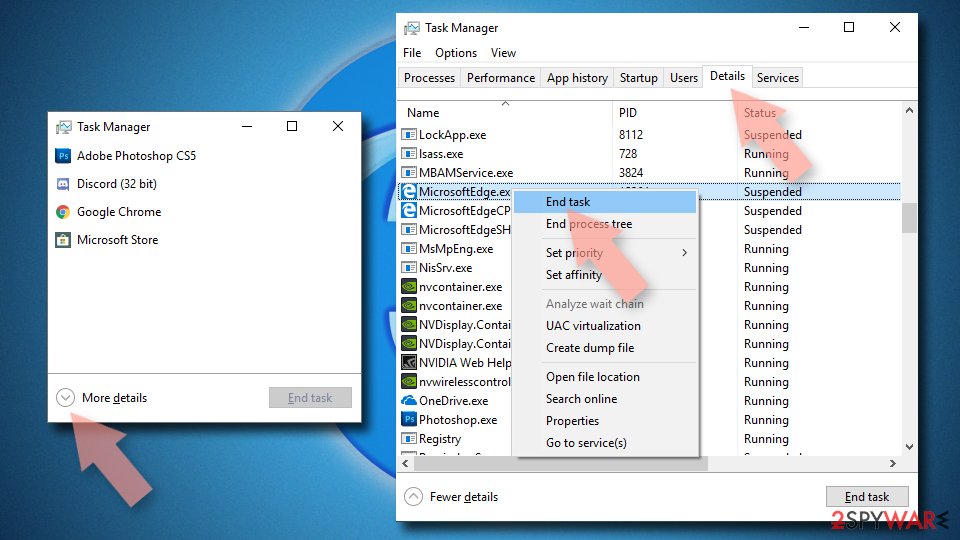
If this solution failed to help you, you need to use an advanced Edge reset method. Note that you need to backup your data before proceeding.
- Find the following folder on your computer: C:\\Users\\%username%\\AppData\\Local\\Packages\\Microsoft.MicrosoftEdge_8wekyb3d8bbwe.
- Press Ctrl + A on your keyboard to select all folders.
- Right-click on them and pick Delete

- Now right-click on the Start button and pick Windows PowerShell (Admin).
- When the new window opens, copy and paste the following command, and then press Enter:
Get-AppXPackage -AllUsers -Name Microsoft.MicrosoftEdge | Foreach {Add-AppxPackage -DisableDevelopmentMode -Register “$($_.InstallLocation)\\AppXManifest.xml” -Verbose

Instructions for Chromium-based Edge
Delete extensions from MS Edge (Chromium):
- Open Edge and click select Settings > Extensions.
- Delete unwanted extensions by clicking Remove.
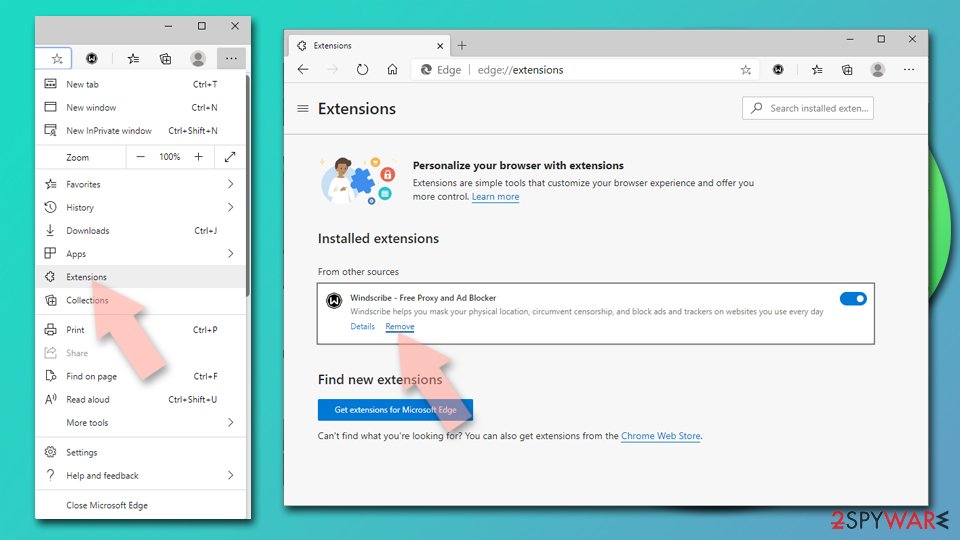
Clear cache and site data:
- Click on Menu and go to Settings.
- Select Privacy, search and services.
- Under Clear browsing data, pick Choose what to clear.
- Under Time range, pick All time.
- Select Clear now.
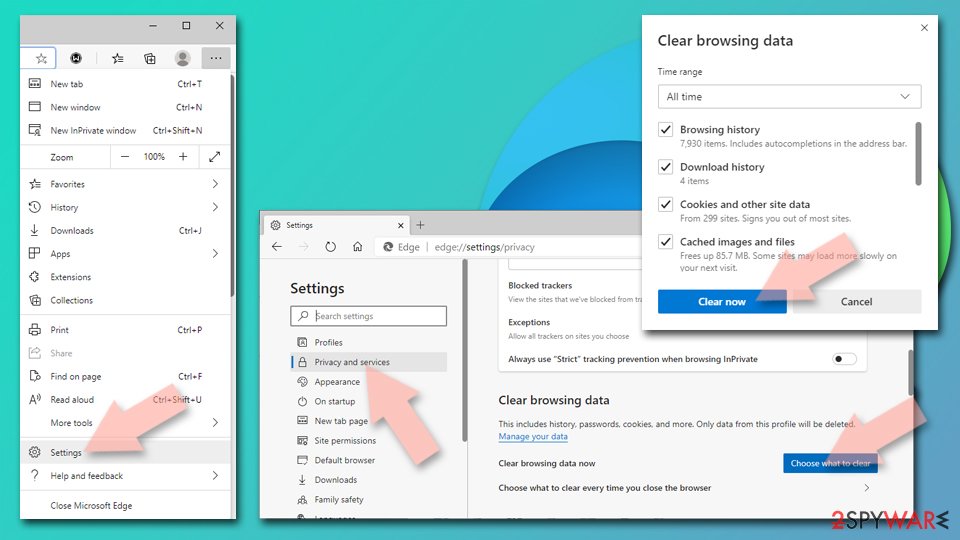
Reset Chromium-based MS Edge:
- Click on Menu and select Settings.
- On the left side, pick Reset settings.
- Select Restore settings to their default values.
- Confirm with Reset.
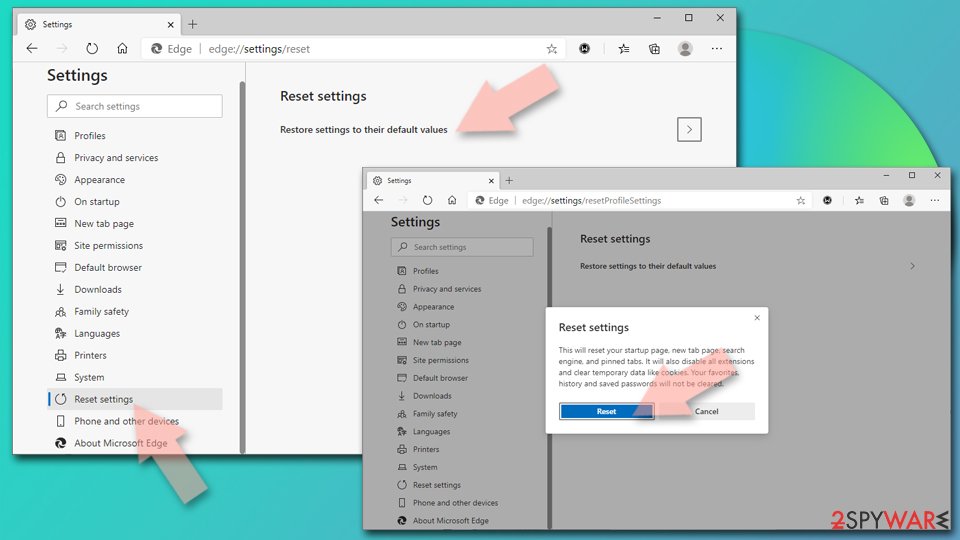
Remove from Mozilla Firefox (FF)
Consider removing V9 add-on from Firefox as well as other vague browser extensions.
Remove dangerous extensions:
- Open Mozilla Firefox browser and click on the Menu (three horizontal lines at the top-right of the window).
- Select Add-ons.
- In here, select unwanted plugin and click Remove.

Reset the homepage:
- Click three horizontal lines at the top right corner to open the menu.
- Choose Options.
- Under Home options, enter your preferred site that will open every time you newly open the Mozilla Firefox.
Clear cookies and site data:
- Click Menu and pick Settings.
- Go to Privacy & Security section.
- Scroll down to locate Cookies and Site Data.
- Click on Clear Data…
- Select Cookies and Site Data, as well as Cached Web Content and press Clear.
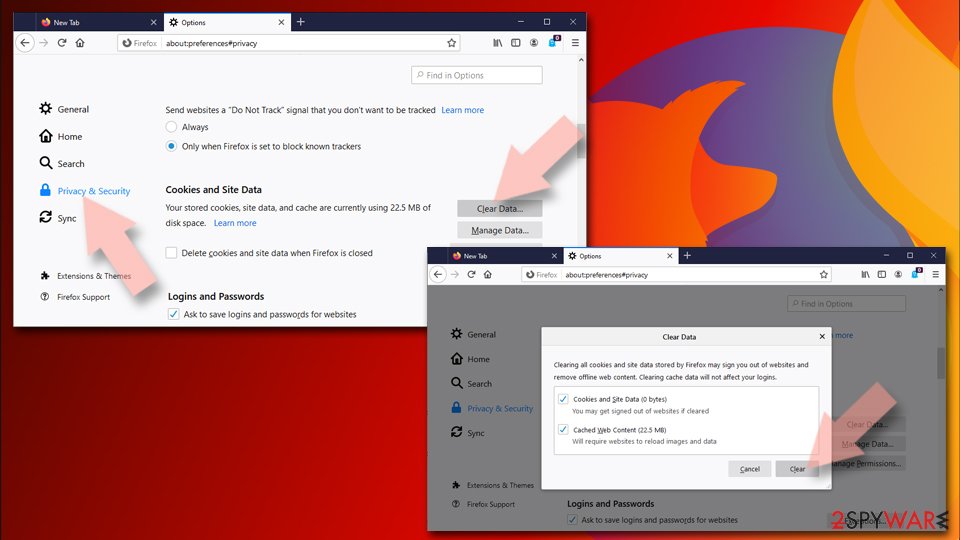
Reset Mozilla Firefox
If clearing the browser as explained above did not help, reset Mozilla Firefox:
- Open Mozilla Firefox browser and click the Menu.
- Go to Help and then choose Troubleshooting Information.
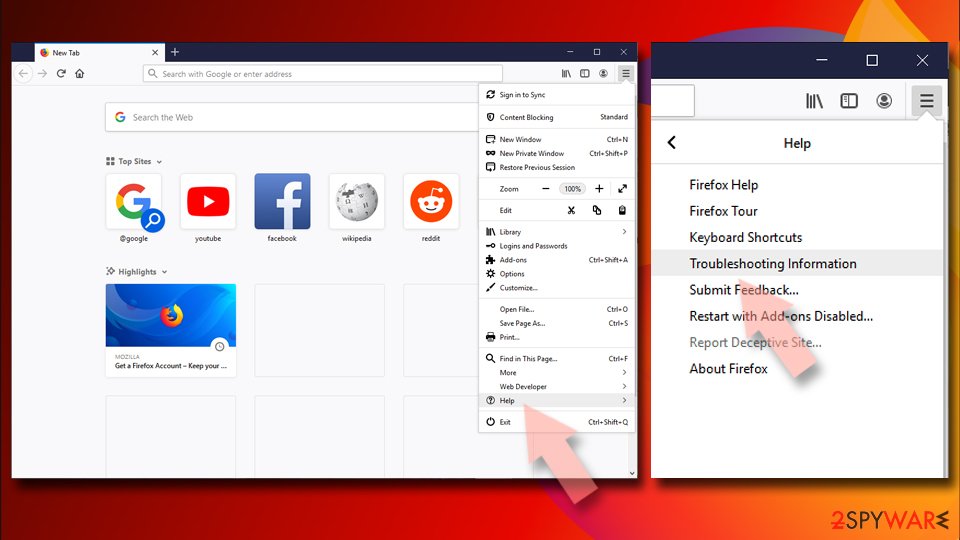
- Under Give Firefox a tune up section, click on Refresh Firefox…
- Once the pop-up shows up, confirm the action by pressing on Refresh Firefox.
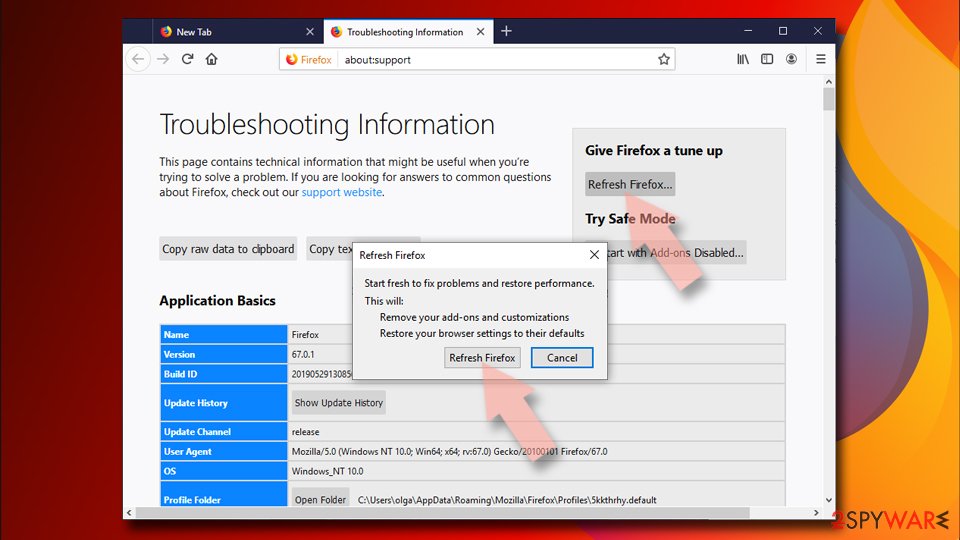
Remove from Google Chrome
Delete V9 extension from Chrome to stop it from causing unwanted browser redirects.
Delete malicious extensions from Google Chrome:
- Open Google Chrome, click on the Menu (three vertical dots at the top-right corner) and select More tools > Extensions.
- In the newly opened window, you will see all the installed extensions. Uninstall all the suspicious plugins that might be related to the unwanted program by clicking Remove.

Clear cache and web data from Chrome:
- Click on Menu and pick Settings.
- Under Privacy and security, select Clear browsing data.
- Select Browsing history, Cookies and other site data, as well as Cached images and files.
- Click Clear data.

Change your homepage:
- Click menu and choose Settings.
- Look for a suspicious site in the On startup section.
- Click on Open a specific or set of pages and click on three dots to find the Remove option.
Reset Google Chrome:
If the previous methods did not help you, reset Google Chrome to eliminate all the unwanted components:
- Click on Menu and select Settings.
- In the Settings, scroll down and click Advanced.
- Scroll down and locate Reset and clean up section.
- Now click Restore settings to their original defaults.
- Confirm with Reset settings.
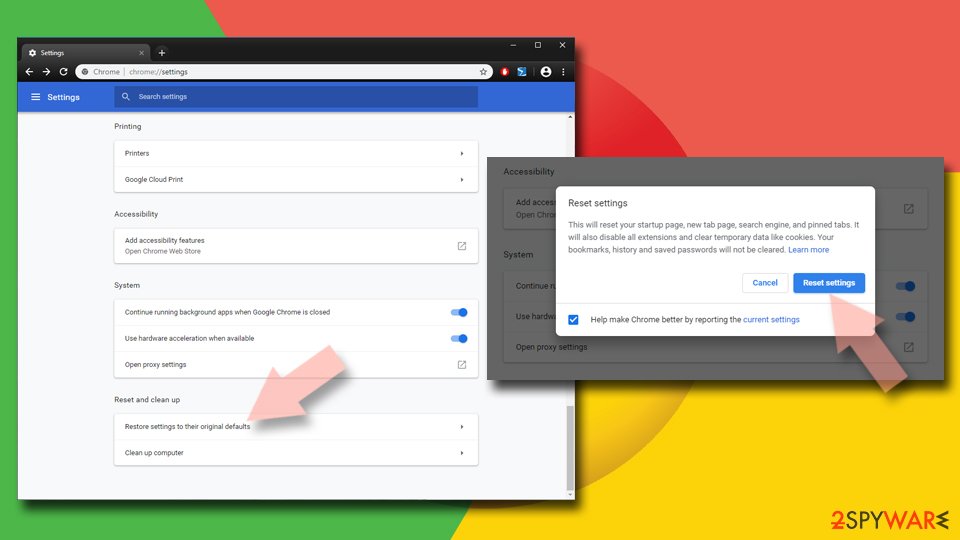
Delete from Safari
Remove unwanted extensions from Safari:
- Click Safari > Preferences…
- In the new window, pick Extensions.
- Select the unwanted extension and select Uninstall.
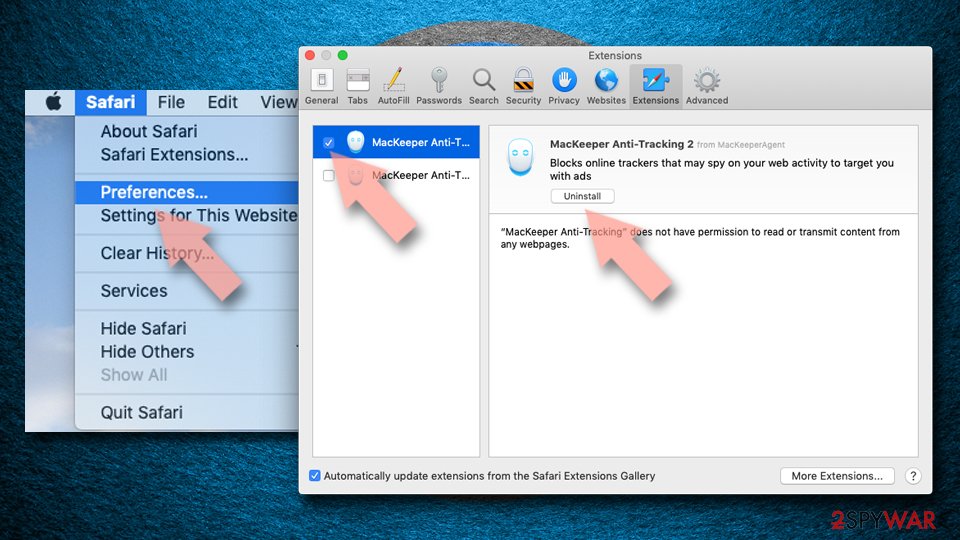
Clear cookies and other website data from Safari:
- Click Safari > Clear History…
- From the drop-down menu under Clear, pick all history.
- Confirm with Clear History.
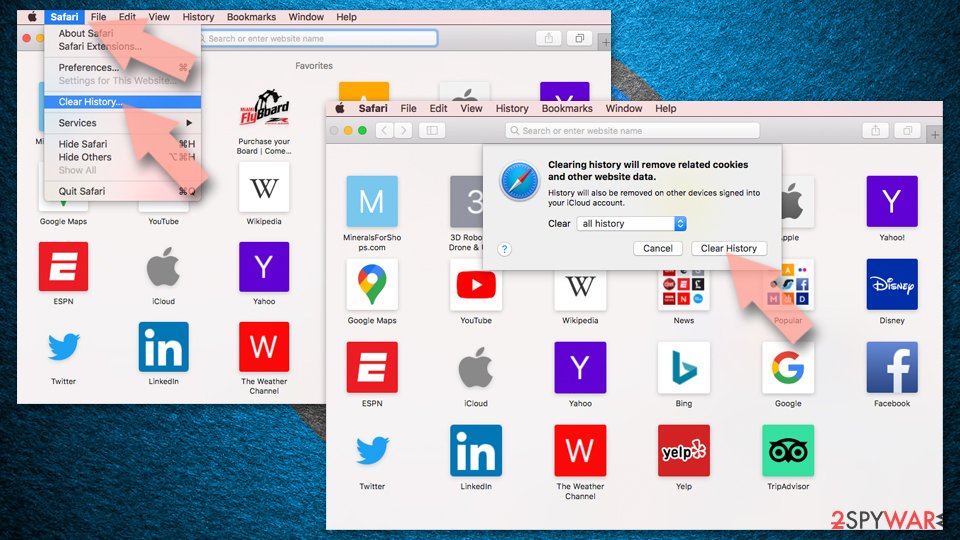
Reset Safari if the above-mentioned steps did not help you:
- Click Safari > Preferences…
- Go to Advanced tab.
- Tick the Show Develop menu in menu bar.
- From the menu bar, click Develop, and then select Empty Caches.
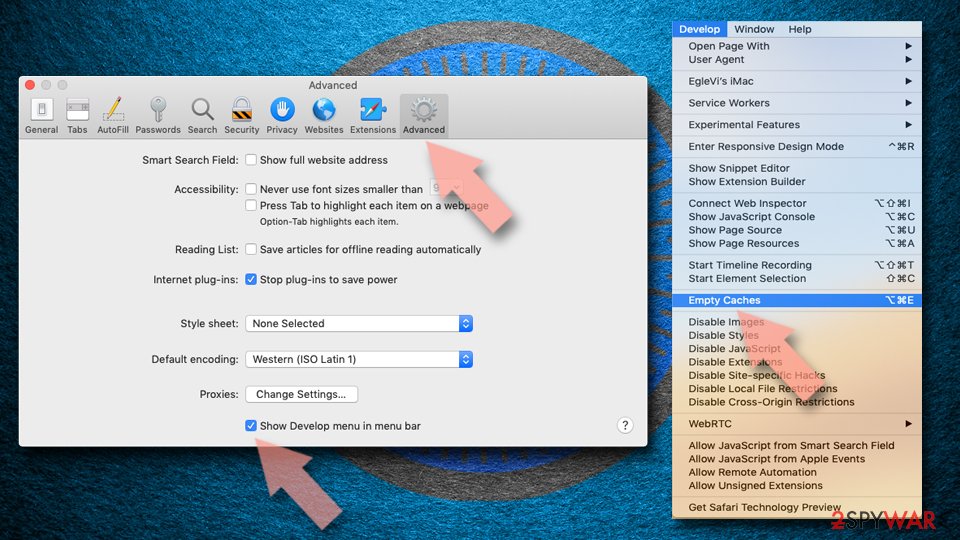
After uninstalling this potentially unwanted program (PUP) and fixing each of your web browsers, we recommend you to scan your PC system with a reputable anti-spyware. This will help you to get rid of v9.com registry traces and will also identify related parasites or possible malware infections on your computer. For that you can use our top-rated malware remover: FortectIntego, SpyHunter 5Combo Cleaner or Malwarebytes.
How to prevent from getting browser hijacker
Choose a proper web browser and improve your safety with a VPN tool
Online spying has got momentum in recent years and people are getting more and more interested in how to protect their privacy online. One of the basic means to add a layer of security – choose the most private and secure web browser. Although web browsers can't grant full privacy protection and security, some of them are much better at sandboxing, HTTPS upgrading, active content blocking, tracking blocking, phishing protection, and similar privacy-oriented features. However, if you want true anonymity, we suggest you employ a powerful Private Internet Access VPN – it can encrypt all the traffic that comes and goes out of your computer, preventing tracking completely.
Lost your files? Use data recovery software
While some files located on any computer are replaceable or useless, others can be extremely valuable. Family photos, work documents, school projects – these are types of files that we don't want to lose. Unfortunately, there are many ways how unexpected data loss can occur: power cuts, Blue Screen of Death errors, hardware failures, crypto-malware attack, or even accidental deletion.
To ensure that all the files remain intact, you should prepare regular data backups. You can choose cloud-based or physical copies you could restore from later in case of a disaster. If your backups were lost as well or you never bothered to prepare any, Data Recovery Pro can be your only hope to retrieve your invaluable files.
- ^ David A. Karp. Fixing Windows XP Annoyances: How to Fix the Most Annoying Things About the Windows OS. Google Books. The World's Most Comprehensive Index of Full-Text Books.
- ^ Andy O'Donnell. How to Test a Suspicious Link Without Clicking it. Lifewire. Tech Untangled.
- ^ LesVirus. LesVirus. Malware and Spyware Removal Guides.
